- Know about the Essence of Shakti in Navaratri, Nine
Manifestations of Ma Durga and Navaratri Puja by Maharashtrians.
Navaratri, literally meaning “nine nights,” stands as one of the most significant festivals in the Hindu calendar, dedicated to the worship of Shakti—the primordial cosmic feminine energy. Over these nine auspicious days, devotees across India, especially women, immerse themselves in rituals, prayers, and festivities that celebrate the multifaceted goddess and her power to create, sustain, and transform the world.
The Essence of Shakti in Navaratri
At
the heart of Navaratri is Shakti, the Divine Feminine worshipped as the source
of all creation and the very powerhouse of the universe. According to ancient
texts such as the Markandeya Purana, Shakti is the Supreme Truth and the cosmic
force from which every form of existence emerges.
Together Shakti
and Lord Shiva symbolise a unique state of balance as the cosmic feminine and
masculine energy.
Both
are incomplete without each other and are present in equal, but complimentary natures.
If sun is the soul, then its light is Shakti. If Soul is the identity, then the
material manifestation of that identity is Shakti.
In
creation, Devi abides in all beings in the form of Cosmic Consciousness. She
pervades in all beings as Intelligence, as Kindness and Contentment. Devi also
abides in all beings in form of Mother and as our Higher Self.
Our
worship of the Divine Mother underlines our need to know the true nature of
Devi, who is present within all of us, but lies dormant. Navratri is the time
to awaken this dormant Shakti or cosmic feminine energy within ourselves. It is
only through redirecting our thoughts towards the Divine that we can be fully
awakened to the discretion of right and wrong, good and the evil. To create a
humane world and better society, we need to strike a balance between Shiva and
Shakti. To strike this balance it is mandatory to awaken the Maa Shakti within
us.
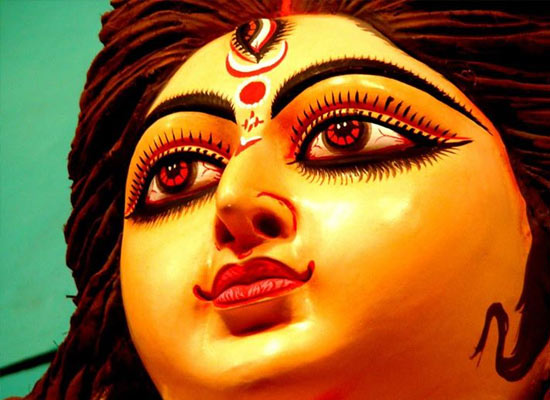
“Navratri” signifies the opening of nine doors of delusions and reaching the tenth, which is the ‘dasham dwar’ – the divine eye, the door to go within. This divine door can be entered only through divine knowledge – Brahma Gyan. But how do we get there?
The word “asur” refers to one who remains engrossed in Tamasic tendencies of the mind, in inertia, ignorance and darkness. Such a Mahishasur is present in all of us. Sometimes he takes control over our internal Divine qualities. It is essential to perform Shakti puja in the nine days of Navratra to become free from this trap of Mahishasur. This inner victory is celebrated on the day of Dashami and is called Dussehra.
During
Navratri, practice your sadhana and purify your inner nature. This is the most
auspicious time in the year for Mother-worship. Read Durga Saptashati or Devi
Mahatmya.
Shakta Hindu traditions show that human life reaches its summit in the celebration of the Divine, of which the mother is the most endearing form. Sadhakas perform sacred rituals, austerities, intense worship and celebrate in the fanfare of the Mother Goddess’s festivities.
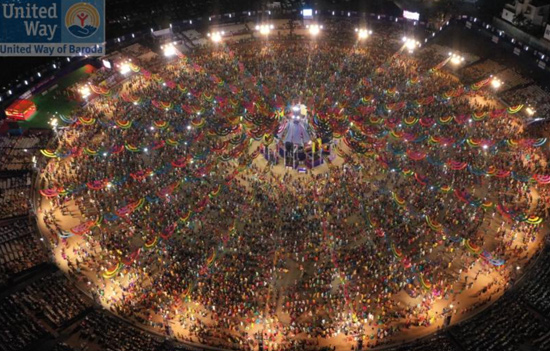 Garba at Baroda.
Garba at Baroda.
Story- In the sacred text the Devi Mahatmya the story of Markandeya Purana Maa Durga was bestowed the grace of all the weapons by the Devata forces to fight the negative force of Mahisasura in her f orm as Chamunda Devi. As a goddess, Maa Durga’s feminine power contains the energies of all the Devata. Each of her weapons was given to her by various Devata: Rudra’s trident, Vishnu’s discus, Indra’s thunderbolt, Brahma’s kamandalu, Kuber’s Ratnahar. After 9 days of aggression Maa Durga emerged victorious on the tenth day which is celebrated as Dussehra or Vijaya Dashmi the triumphant victory of the Goddess.

Rahu
energy signifies our worldly temptations and distractions. Rahu serves us the
higher purpose of grounding in our spiritual self through discrimination and
sadhana. The Navaratri is the best time to tame this Rahu force with the Durga
Raksha mantra.
The
Nine days of Shakti worship symbolize dealing with our own samsaric karmas of
worldly maya. Connecting with the deeper potential of the Mother Goddess we
spiritualize our lives seeking out the higher self.
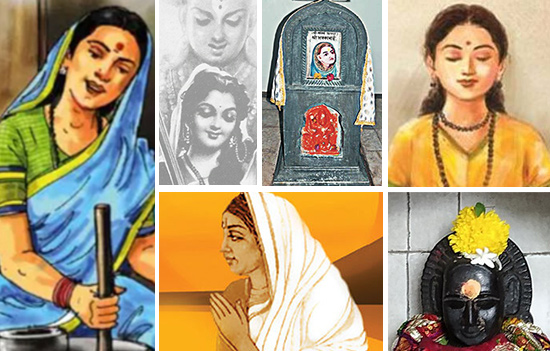 Woman Sants of Maharashtra were leaders in
Socio-Religious Reform.
Woman Sants of Maharashtra were leaders in
Socio-Religious Reform.
Navadurga or Nine Manifestations of
Durga
The
central ritual of Navaratri involves the sequential worship of nine aspects of
Goddess Durga, each representing distinctive qualities and powers:
1. ‘Sri Shailaputri’- daughter of the Himalayas yielding steadfastness
2. ‘Sri Brahmacharini’- personifying purity, deep love and shraddha
3. ‘Sri Chandraghanta’- who holds the power and soma of the Moon
4. ‘Sri Khusmanda’ - unfolds bliss, happiness and well-being
5. ‘Sri Skandamata’- Mother of Skanda, she personifies eternal fire
6. ‘Sri Katyayani’- the power of transformation as the aspect of Ma Kali
7. ‘Sri Kalaratri’ - destroyer of darkness and ignorance.
8. ‘Sri Mahagauri’ - bestower of purity and endless virtues
9. ‘Sri Siddhidatri’ - bestowal of all accomplishments, spiritual powers and knowledge.
Each
night is devoted to invoking these forms through rituals, prayers, and specific
mantras, guiding devotees from darkness to enlightenment.
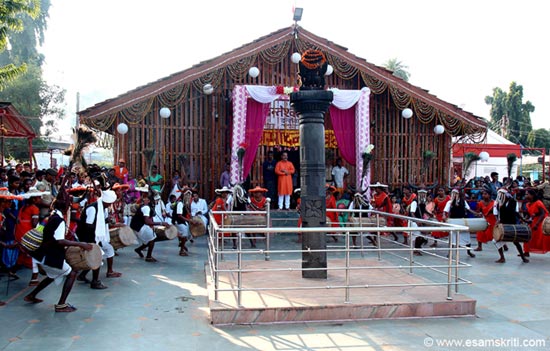 Gaur Dance outside Ma Danteshwari Mandir, Dantewada, Bastar.
Gaur Dance outside Ma Danteshwari Mandir, Dantewada, Bastar.
Rituals, Traditions, and Regional
Variations
All offerings and prayer with deep shraddha (conscious faith) and reverence paves the way for the Devi’s benevolence and divine grace.
Navaratri Puja by Maharashtrians-
1. Ghatasthapana - Maharashtrian devotee
creates sacred space by placing an image of goddess and Ghata. For the puja we
place a Kalasha, the clay or metal pot filled with water and decorate it with a
coconut and Mango or betel nut leaves. Maharashtrians do not keep lamp in Ghat,
but Gujaratis keep lamp in Ghat and their Ghat is percolated Jar. Tie the moli
or red thread around its mouth.
2. Mala or Flower Garland - In front of
Kalash, a flower garland is tied to stick every day. Thus, there nine Mala-s
are tied for nine days.
3. Nandadeepa or Akhandjyot – Lighting a ghee lamp constantly through the nine nights and days. The flame represents the presence of Shakti so we ensure She is ever present. Staying awake at night unfolds many spiritual experiences. This takes a lot of nurturing, shraddha, deep faith, vigilance, concentration and alertness.
4. Hariyali – Navaratri marks the symbolism of fertility and auspiciousness with the nurturing of the ‘Hariyali’, where barley /rice/wheat seeds are planted in a clay pot and closely nurtured every day through the nine days. After the nine days this pot is offered at the temple or into flowing waters. Devotees offer red flowers, rice, pomegranate and two sticks of incense to the Goddess. They offer her the Arati with mantras or her sacred verses.
5. Lalita Panchami or the fifth day
it is customary to seek the blessings of Shri Lalita Devi by offering forty-eight
kinds of grass as symbol of fertility, sacred lamp and invoke the blessings of her.
Symbolism - The Ghat and Hariyali are symbols of fertility. Ghat is symbol of womb. Hariyali is symbol of harvest. Goddess Lalita is Mother Goddess. She is creator and nourishes the Srishti. Navaratri is festival of Creation. It is symbol of Motherhood. Mother Earth and all the Goddess are symbols of the Mother. They give birth and sustain and protect the created.
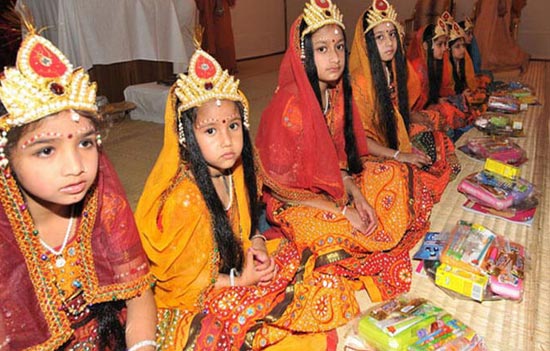
6. Kanchika Pujan or Kumari Puja - During the
Navaratri young girls are worshipped for nine consecutive days, offering them
meals. A nubile girl symbolizes the unmanifest pure Shakti which we must revere
to draw into our own consciousness. On the last day of the Navaratri we invite
9 young girls and revere them with washing their feet, offering them prasada
and giving them a token.
7. Savashna Pujan - A married
(whose husband is alive and having a child) woman is invited for lunch on the
First Day, Fifth Day and the last day of Navaratri.
8. Naivedya - Offering
consecrated food to the Goddess. Generally Puranpoli is main pakwan i.e. sweet
along with two subjis, varan bhat, (dal-rice) Bhajaniche Vade, Koshimbir, raita
are offered on First, Fifth and Last Day.
During Navaratri
we prepare sattvic, pure food dishes for the Goddess, as is customary. The devotees
fast on all the days and have meal only once.
Read
about 9
Women Sants of Maharashtra who were leaders in Social Reform
Spiritual Victory and the Significance
of Dussehra
Navaratri concludes with Dussehra, marking the goddess Durga’s triumph over the demon Mahishasura - a profound allegory for the victory of higher consciousness over ignorance and destructive tendencies. The celebration, therefore, is not just a remembrance of mythological events, but an invitation to internalize the goddess’s virtues and overcome one’s own inner negativity.
Read How
Dussehra is celebrated across India n Mardangi
Dussehra at Jejuri Temple near Pune
Dussehra
in Bastar is spread over 75 days and is essentially celebrated by the Vanvasis
in a unique way. It starts at Ma Danteshwari Mandir To see album
Conclusion
Navaratri
is far more than a ritualistic celebration; it
is a journey of spiritual renewal, empowerment, and recognition of the divine
feminine within all existence. Through devotion, self-purification, and
honouring the goddess in all women, the festival kindles hope, balance, and a
reaffirmation of universal harmony and peace.
To read all
articles by author
Also read articles/albums
on Durga Puja/Dussehra
1. All
about Durga Worship
2. Nine
Nights of Women Power
3. Worship
of God as Mother in Indian Tradition
4. Durga
Puja Pandal Hopping in Kolkata
5. Durga
Puja is celebrated across Bharat
6. How
Dussehra is celebrated across India
7. Bastar
Dussehra
8. Garba
Dandiya at Baroda
9. Mysore
Dussehra
10. Mardangi
Dussehra at Jejuri Temple near Pune
11. Kullu
Dussehra
12. Kumaon
ki Ram Lila
13. Ramnagar
Ramlila
14. Ramayana
performance in Indonesia
15. Ramayana
performance in Thailand
16. Ramayana
performance across India
17. Ramayana
performances in Sri Lanka
18.
9
Women Sants of Maharashtra who were leaders in Social Reform